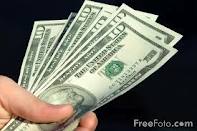|
Foreign exhange rate maintains stability
The State Bank of Viet Nam has kept the dong-dollar exchange rate at below VND20,828 for nearly 11 months, and it is predicted to remain stable for the rest of the year.

The rates listed at banks have also been around VND20,800 for buying and 20,830 for selling except for a slight increase in September because of a spurt in gold prices.
The stable foreign exchange rates are testimony that the SBV's monetary policies have sustained investors' confidence in the dong.
The stability is also attributed to the close oversight of the market by the central bank since late 2011.
The SBV governor had promised late last year to keep the exchange rate fluctuating within 2-3 per cent this year as part of a drive to limit dollarisation and forex speculation.
The central bank's policy of keeping interest rates on dong deposits higher than on dollar deposits has strengthened the local currency against the greenback.
It has helped limit speculation and keep dollars circulating freely in the market, thus improving the country's foreign currency reserves.
The central bank has also actively bought foreign exchange to strengthen the reserves.
As a result, they have risen to US$22 – 23 billion, equivalent to 11.5 weeks of imports, up from being just enough for nine weeks of imports in June.
Thanks to the higher reserves, the central bank is able to step in with timely open market operations (OMO) to maintain market liquidity.
Besides, the gold market has been revamped and placed under a strict control mechanism, sharply reducing speculation and significantly easing pressure on the forex rate.
The forex stability is also owed to plentiful inflow of foreign currency through direct foreign investment and inward remittances.
In the first nine months, $8.1 billion was brought in by foreign companies, while the remittances are estimated at around $10 billion.
Finally, the US Government's policy to keep the dollar weak through "quantitative easing" has also helped stabilise the exchange rate in Viet Nam.
Property prices plunge
Recently the real estate market witnessed a relentless fall in prices, with the prices of many apartments coming down from VND30-40 million per square metre to just VND10 million.
Hoang Anh Gia Lai Joint Stock Company typifies this trend. In May it suddenly cut prices at some its projects by 50 per cent, taking many people by surprise.
But now this practice has taken hold and has been adopted at many property projects in major cities like Ha Noi and HCM City and in the central region where prices were cut by 50 and even 70-80 per cent.
But the price cuts and other measures adopted by property firms like reducing apartment s and providing financial support to revive the market have been in vain because of lack of confidence among investors.
Many of the firms have realised that the confidence crisis is much worse than the other problems they face.
Homebuyers have lost their confidence primarily because many builders failed to finish their projects and hand over apartments in time due to lack of funds.
In many cases the delays have been indefinite, while in others it has been a dead loss for the buyers after builders defaulted.
As a result, freebies and price cuts have only helped up to a point, and only developers gaining customers' trust have been able to sell.
Homebuyers always want to know if they can get their houses on schedule, and if they have to pay newly arising expenses.
A survey of prospective buyers after some developers cut prices by 50 per cent found that the former are only interested in projects to be finished within one or two years.
Everyone wants to ensure that an apartment they buy will be finished.
Trade deficit ignites fears
Viet Nam enjoyed a trade surplus of $34 million in the first nine months of this year, a huge improvement from the $8.1 billion deficit at the same time last year.
The Ministry of Industry and Trade expects exports to top $113 billion this year and imports to cost $114 billion, meaning the trade deficit will be only $1 billion.
The Government has announced an import-export strategy for the 2011-20 period under which exports and imports are projected to grow by 11 – 12 per cent and 10 – 11 per cent per year respectively.
The programme also seeks to gradually lower the trade deficit, balancing trade by 2020 and achieving a surplus by 2030.
This means that if the country's import and export values are maintained the country's goal of balancing imports and exports set for the period of 2011 and 2020 will be realised eight years earlier.
But delve a little deeper, and the trade figures this year, especially the elimination of the deficit, is not a positive thing.
This is because Viet Nam still relies heavily on imports in most areas like manufacturing, construction, traffic, transportation, and even agriculture.
Thus, a shrinking of imports like now indicates possible problems.
Thousands of companies have had to cut back on or stop production due to rising inventories. So their demand for raw materials has reduced.
According to the Government, as of September 1 unsold products at processing and manufacturing enterprises had increased by a fifth compared to the same period last year.
Among the worst affected industries were cement, steel (up 40 per cent), animal feed, seafood, garment and textile, fertiliser, electric cables, and motorbikes.
Consequently, import of 20 items for feedstock has declined strongly. They include urea fertiliser (down by 61 per cent), animal fats (78) per cent, cotton (79) and steel ingots (48).
All this points to the fact that balanced trade is a danger signal that points to a decelerating economy.
In any case, the official import figures do not include the massive smuggling that goes on over land, water, and air, and is becoming increasingly sophisticated.
Smugglers bring in everything from toothpicks to medicines and poisonous chemicals into the country.
vietnamnews
|